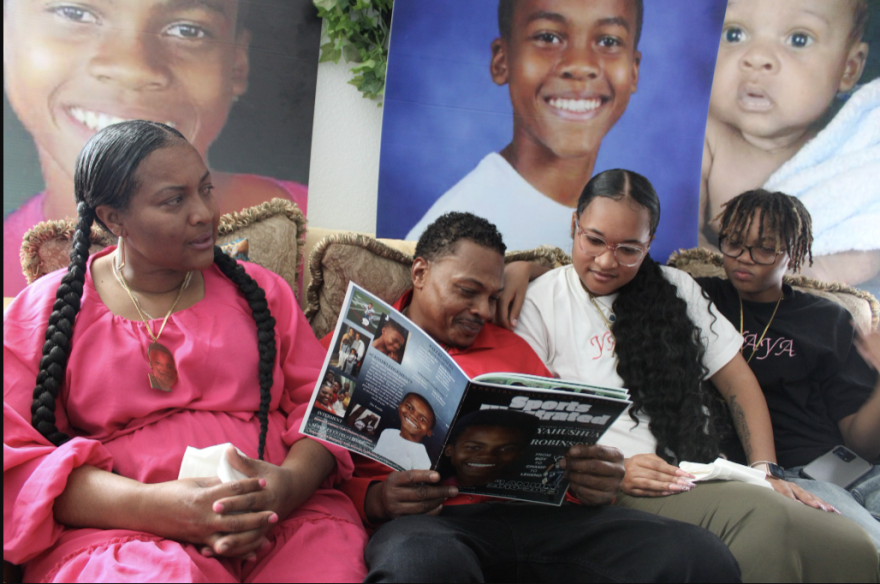Truth matters. Community matters. Your support makes both possible. LAist is one of the few places where news remains independent and free from political and corporate influence. Stand up for truth and for LAist. Make your tax-deductible donation now.
After A Child’s Death, California Weighs Rules for Phys Ed During Extreme Weather

Yahushua Robinson was an energetic boy who jumped and danced his way through life. Then, a physical education teacher instructed the 12-year-old to run outside on a day when the temperature climbed to 107 degrees.
“We lose loved ones all the time, but he was taken in a horrific way,” his mother, Janee Robinson, said from the family’s Inland Empire home, about 80 miles southeast of Los Angeles. “I would never want nobody to go through what I’m going through.”
The day her son died, Robinson, who teaches phys ed, kept her elementary school students inside, and she had hoped her children’s teachers would do the same.
The Riverside County Coroner’s Bureau ruled that Yahushua died on Aug. 29 of a heart defect, with heat and physical exertion as contributing factors. His death at Canyon Lake Middle School came on the second day of an excessive heat warning, when people were advised to avoid strenuous activities and limit their time outdoors.
Yahushua’s family is supporting a bill in California that would require the state Department of Education to create guidelines that govern physical activity at public schools during extreme weather, including setting threshold temperatures for when it’s too hot or too cold for students to exercise or play sports outside. If the measure becomes law, the guidelines will have to be in place by Jan. 1, 2026.

Many states have adopted protocols to protect student athletes from extreme heat during practices. But the California bill is broader and would require educators to consider all students throughout the school day and in any extreme weather, whether they’re doing jumping jacks in fourth period or playing tag during recess. It’s unclear if the bill will clear a critical committee vote scheduled for May 16.
“Yahushua’s story, it’s very touching. It’s very moving. I think it could have been prevented had we had the right safeguards in place,” said state Sen. Melissa Hurtado (D-Bakersfield), one of the bill’s authors. “Climate change is impacting everyone, but it’s especially impacting vulnerable communities, especially our children.”
Last year marked the planet’s warmest on record, and extreme weather is becoming more frequent and severe, according to the National Oceanic and Atmospheric Administration. Even though most heat deaths and illnesses are preventable, about 1,220 people in the United States are killed by extreme heat every year, according to the Centers for Disease Control and Prevention.
Young children are especially susceptible to heat illness because their bodies have more trouble regulating temperature, and they rely on adults to protect them from overheating. A person can go from feeling dizzy or experiencing a headache to passing out, having a seizure, or going into a coma, said Chad Vercio, a physician and the division chief of general pediatrics at Loma Linda University Health.
“It can be a really dangerous thing,” Vercio said of heat illness. “It is something that we should take seriously and figure out what we can do to avoid that.”

It’s unclear how many children have died at school from heat exposure. Eric Robinson, 15, had been sitting in his sports medicine class learning about heatstroke when his sister arrived at his high school unexpectedly the day their brother died.
“They said, ‘OK, go home, Eric. Go home early.’ I walked to the car and my sister’s crying. I couldn’t believe it,” he said. “I can’t believe that my little brother’s gone. That I won’t be able to see him again. And he’d always bugged me, and I would say, ‘Leave me alone.’”
That morning, Eric had done Yahushua’s hair and loaned him his hat and chain necklace to wear to school.
As temperatures climbed into the 90s that morning, a physical education teacher instructed Yahushua to run on the blacktop. His friends told the family that the sixth grader had repeatedly asked the teacher for water but was denied, his parents said.
The school district has refused to release video footage to the family showing the moment Yahushua collapsed on the blacktop. He died later that day at the hospital.
Melissa Valdez, a Lake Elsinore Unified School District spokesperson, did not respond to calls seeking comment.

Schoolyards can reach dangerously high temperatures on hot days, with asphalt sizzling up to 145 degrees, according to findings by researchers at the UCLA Luskin Center for Innovation. Some school districts, such as San Diego Unified and Santa Ana Unified, have hot weather plans or guidelines that call for limiting physical activity and providing water to kids. But there are no statewide standards that K-12 schools must implement to protect students from heat illness.
Under the bill, the California Department of Education must set temperature thresholds requiring schools to modify students’ physical activities during extreme weather, such as heat waves, wildfires, excessive rain, and flooding. Schools would also be required to come up with plans for alternative indoor activities, and staff must be trained to recognize and respond to weather-related distress.
California has had heat rules on the books for outdoor workers since 2005, but it was a latecomer to protecting student athletes, according to the Korey Stringer Institute at the University of Connecticut, which is named after a Minnesota Vikings football player who died from heatstroke in 2001. By comparison, Florida, where Gov. Ron DeSantis, a Republican, this spring signed a law preventing cities and counties from creating their own heat protections for outdoor workers, has the best protections for student athletes, according to the institute.
Douglas Casa, a professor of kinesiology and the chief executive officer of the institute, said state regulations can establish consistency about how to respond to heat distress and save lives.
“The problem is that each high school doesn’t have a cardiologist and doesn’t have a thermal physiologist and doesn’t have a sickling expert,” Casa said of the medical specialties for heat illness.
In 2022, California released an Extreme Action Heat Plan that recommended state agencies “explore implementation of indoor and outdoor heat exposure rules for schools,” but neither the administration of Gov. Gavin Newsom, a Democrat, nor lawmakers have adopted standards.
Lawmakers last year failed to pass legislation that would have required schools to implement a heat plan and replace hot surfaces, such as cement and rubber, with lower-heat surfaces, such as grass and cool pavement. That bill, which drew opposition from school administrators, stalled in committee, in part over cost concerns.
Naj Alikhan, a spokesperson for the Association of California School Administrators, said the new bill takes a different approach and would not require structural and physical changes to schools. The association has not taken a position on the measure, and no other organization has registered opposition.
The Robinson family said children’s lives ought to outweigh any costs that might come with preparing schools to deal with the growing threat of extreme weather. Yahushua‘s death, they say, could save others.
“I really miss him. I cry every day,” said Yahushua’s father, Eric Robinson. “There’s no one day that go by that I don’t cry about my boy.”

KFF Health News is a national newsroom that produces in-depth journalism about health issues and is one of the core operating programs at KFF—an independent source of health policy research, polling, and journalism. Learn more about KFF.







